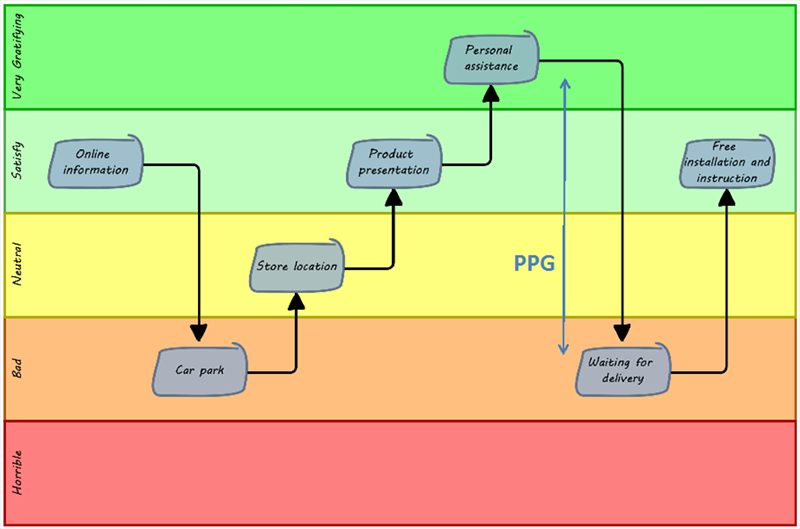There is a lot of power in Business Process Management (BPM) and process thinking. Our process flow diagrams describe ‘what is done’, and support us in designing, improving and controlling our processes. The results of processes should be of value to our customers. But how do our customers experience our processes? A very powerful technique, aimed at customer experience, is the Customer Journey. It is a must-have technique for your BPM/Lean toolkit!
Traditional manufacturing organizations create products for customers. In such organizations, the customer is only involved at the beginning of the process (product order) and at the end of the process (product delivery). The customer is not present during the execution of the process, which is usually quite handy: this allows us to optimize the process flow without customer interruptions. Quality and customer value is mainly determined by the product that is created and delivered.
Service organizations are different. We execute the process and serve the customer simultaneously. The customer is directly involved in (parts of) the process. This requires a different perspective on quality and customer value. Value is delivered not only in the last process step – the result, but it is also ‘created’ by the experiences of the customer in the process.
Nowadays, customer ‘experience’ is becoming increasingly important. If you want to build an interesting business, you need to offer something special. For example, travel agents cannot differentiate themselves from the competition by selling ordinary city breaks. But if they offer a special experience, say, a city break with local guidance – that’s something different. Everybody loves a good experience!
There is something interesting with experiences. To stick with the holiday example: imagine your favorite vacation. Fun activities, beautiful views, amazing culture, outstanding hotels and delicious food are all things that come to mind. However, once you remove the rose-colored glasses and think a little deeper, you also remember some contrasts in your experiences. On that same trip, perhaps your flight was delayed, you were stuck in a terrible hotel, or you were seasick on the boat. It is the combination of bad experiences (four days of rain) and pleasurable experiences (then the skies cleared up and we had the perfect view of the mountain range) that together make a great experience.
Organizations strive to deliver value to customers. If they deliver good value, customers will be satisfied and likely to return. This allows the organization to stay in business. It is that simple, right? The important question here is: ‘Are satisfied customers more loyal than unsatisfied customers?’ We would tend to say ‘yes’, but in todays volatile world the answer is ‘no’. Simply doing a ‘good job’ and ‘satisfying’ customers does not guarantee that the customers will come back. To really turn customers into promoters, organizations need to deliver an experience. It’s all about the customer journey.
The Customer Journey technique illustrates and analyzes the experiences of customers in the process. It works with touch points, where interaction takes place with customers. By connecting these touch points, we create insight in the journey that customers travel. We can map this journey in a process flow diagram as demonstrated below.

The Customer Journey technique
To analyze and improve the customer journey there are some important lessons:
The Customer Journey technique is used by large organizations such as IKEA. They are masters in managing customer experience. Most of us are familiar with the IKEA customer journey: from parking, to decoration, the ‘showroom’, product quality, the canteen, self-service pick up, pricing and check out. We can see the contrast (very satisfying quality vs. annoying self-service pick up). And of course the journey ends with a peak: the ice-cream/ hot-dog after check-out!
Maybe your organization can be even better than IKEA. The Customer Journey provides techniques and lessons that apply to all (service) processes. I know from personal experience that a few small and smart process improvements can dramatically improve the customer experience.
Good luck improving the customer journey in your organization!